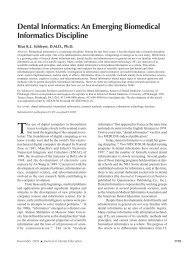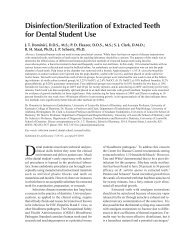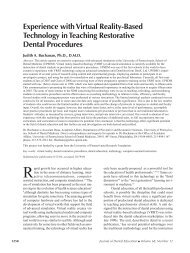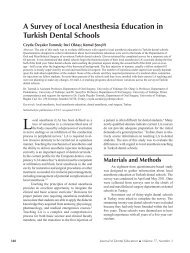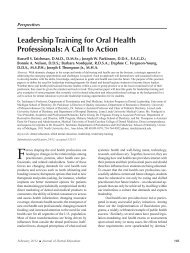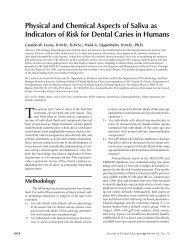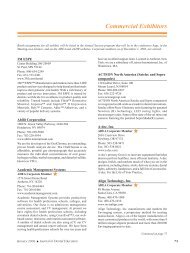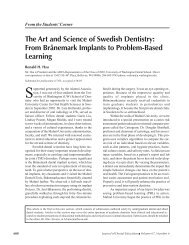List of Poster Presentations - Journal of Dental Education
List of Poster Presentations - Journal of Dental Education
List of Poster Presentations - Journal of Dental Education
You also want an ePaper? Increase the reach of your titles
YUMPU automatically turns print PDFs into web optimized ePapers that Google loves.
<strong>Poster</strong> Abstracts<br />
Block I<br />
Monday, March 4<br />
2:00 p.m. - 3:30 p.m.<br />
1. African-American Pre-Health And Pr<strong>of</strong>essional<br />
Health Students’ Oral Hygiene Knowledge and<br />
Compliance<br />
Alexander, Keisha N., Meharry Medical College School <strong>of</strong> Dentistry,<br />
Bazzey, Debra M., Meharry Medical College School <strong>of</strong> Dentistry,<br />
Mason, Talisha A., Meharry Medical College School <strong>of</strong> Dentistry,<br />
Farmer-Dixon, Cherae M., Meharry Medical College School <strong>of</strong><br />
Dentistry<br />
Purpose: A survey was conducted to assess the knowledge <strong>of</strong><br />
dental health and oral hygiene practices among pre-health and<br />
pr<strong>of</strong>essional African-American students.<br />
A lack <strong>of</strong> compliance with dental health and oral hygiene habits<br />
may predispose one to carious lesions. A survey was conducted to<br />
assess the knowledge <strong>of</strong> dental health and oral hygiene practices<br />
among pre-health and pr<strong>of</strong>essional health African-American students.<br />
Approximately 197 students at Meharry Medical College <strong>of</strong> various<br />
classifications in Medicine and Dentistry, as well as students<br />
participating in Summer pre-health programs were surveyed. From<br />
the total number <strong>of</strong> students surveyed, 128 were women and 69 were<br />
men. All <strong>of</strong> the <strong>of</strong> students surveyed have received a variety <strong>of</strong> dental<br />
services throughout the course <strong>of</strong> their lifetime. However, the<br />
information gathered from this study indicated that there was a lack<br />
<strong>of</strong> compliance with proper oral hygiene habits such as the frequency<br />
<strong>of</strong> brushing, flossing, and high sugar consumption. The data indicated<br />
that the level <strong>of</strong> caries was inversely proportional to compliance with<br />
proper oral hygiene habits among the students surveyed. We further<br />
conclude that in addition to educating the patient, mechanisms for<br />
compliance are essential to good oral hygiene.<br />
The data indicated that the level <strong>of</strong> caries was inversely<br />
proportional to compliance with proper oral hygiene habits among<br />
the students surveyed.<br />
2. Process Issues in Making a Transition to On-Line<br />
Learning in a Team Taught Course<br />
Bauchmoyer, Susan M., The Ohio State University College <strong>of</strong><br />
Dentistry, Rudmann, Sally, The Ohio State University School <strong>of</strong> Allied<br />
Health <strong>Education</strong>, Carr, Michele P, The Ohio State University College<br />
<strong>of</strong> Dentistry<br />
The purpose/objective <strong>of</strong> this project was to engage faculty<br />
members, students and technical/design support personnel in the<br />
adaptation <strong>of</strong> a team taught web-enhanced course, to a team taught<br />
distance learning course.<br />
Transforming a team-taught web-enhanced course to a distance<br />
learning format raises many issues for course directors to consider<br />
both technically and pedagogically. Faculty members may have limited<br />
experience with on-line courses and <strong>of</strong>ten express concerns regarding<br />
educational quality, changes in traditional classroom interaction,<br />
expected revision <strong>of</strong> present teaching modalities and their anticipated<br />
role in this new process. The objective <strong>of</strong> this project was to engage<br />
faculty members, students and technical/design support personnel in<br />
the adaptation <strong>of</strong> a team taught web-enhanced course, to a team taught<br />
distance learning course. The course director, graduate students and<br />
technical/design personnel examined the course as a whole,<br />
determined overall goals, evaluated content, identified current<br />
teaching methodology and accessed previous student evaluations. A<br />
questionnaire was developed and utilized during an interview <strong>of</strong> all<br />
faculty to gather course objectives, content materials and address<br />
individual concerns. The course director examined the questionnaire<br />
summary and a decision was made to begin the transition by placing<br />
one faculty member’s materials totally online. The remaining faculty<br />
were to polish their course objectives and where applicable, submit<br />
class assignments and identify hyperlinks to lead students to quality<br />
resource materials. During the first quarter, all faculty were<br />
encouraged to participate in all online segments <strong>of</strong> the class and their<br />
input will be considered in further implementation <strong>of</strong> distance format<br />
changes. Upon completion <strong>of</strong> the course, students provided a formative<br />
evaluation <strong>of</strong> their experience with the total distance module through<br />
an on-line survey. Student evaluations support further expansion <strong>of</strong><br />
the distance learning format.<br />
Upon completion <strong>of</strong> the course, students provided a formative<br />
evaluation <strong>of</strong> their experience with the total distance module through<br />
an on-line survey. Student evaluations support further expansion <strong>of</strong><br />
the distance learning format.<br />
3. Trends in <strong>Dental</strong> Specialty <strong>Education</strong> and Practice:<br />
A Ten-Year Perspective<br />
Boehm, Diane M., American <strong>Dental</strong> Association, Nix, Judith A.,<br />
American <strong>Dental</strong> Association, Neumann, Laura M., American <strong>Dental</strong><br />
Association<br />
Purpose: To review the trends in dental education and practice<br />
<strong>of</strong> the ADA recognized specialties over a ten-year period.<br />
The ADA’s Council on <strong>Dental</strong> <strong>Education</strong> and Licensure (CDEL)<br />
conducted a review <strong>of</strong> dental specialty education and practice to<br />
identify and analyze trends in dental specialty education and practice<br />
covering a ten-year period from 1991-2001. The results highlight<br />
trends that have occurred over the last ten years regarding membership<br />
in the specialty organizations; number <strong>of</strong> active diplomates; number<br />
<strong>of</strong> educational programs, and program enrollments and graduates.<br />
Membership figures for all but one specialty organization have<br />
remained steady or increased slightly. The number <strong>of</strong> active diplomates<br />
in the specialties has increased except in two specialties. For most<br />
dental specialties, the number <strong>of</strong> specialty education programs has<br />
remained relatively stable and the number <strong>of</strong> graduates in all dental<br />
specialties increased slightly. The length <strong>of</strong> the educational programs<br />
increased in three specialties. Additionally, the ratio <strong>of</strong> general dentists<br />
to specialists has remained fairly constant in the last ten years (80%<br />
general dentists: 20% specialists). Changes in scope <strong>of</strong> practice were<br />
noted as influenced by environmental trends such as oral health<br />
disparities; tooth retention awareness; the aging population and<br />
expansion <strong>of</strong> prescription drug therapy; a shift in health care delivery<br />
from hospital settings to an ambulatory care facilities; continued high<br />
dental caries rates in some children; and the possible link between<br />
periodontal disease and systemic conditions. The study also noted<br />
that the specialties shared some common concerns and interests<br />
including faculty shortages, referral patterns and increasing the<br />
number <strong>of</strong> board certified specialists. Based on the data and other<br />
information reviewed for the purposes <strong>of</strong> this study, the CDEL<br />
concluded that the recognized dental specialties have documented<br />
that they are in a healthy and viable state.<br />
The ADA recognized dental specialties have documented that<br />
they are in a healthy and viable state.<br />
4. An Interactive Approach to Learning Cranial Nerve<br />
Anatomy<br />
Brueckner, Jennifer K., University <strong>of</strong> Kentucky Medical Center, Dolan,<br />
Thomas J., University <strong>of</strong> Kentucky Medical Center, Wong-Rutledge,<br />
Kathryn M., University <strong>of</strong> Kentucky Medical Center<br />
This multimedia tutorial is designed to facilitate student<br />
comprehension <strong>of</strong> cranial nerve anatomy and function.<br />
258 <strong>Journal</strong> <strong>of</strong> <strong>Dental</strong> <strong>Education</strong> ■ Volume 66, No. 2



